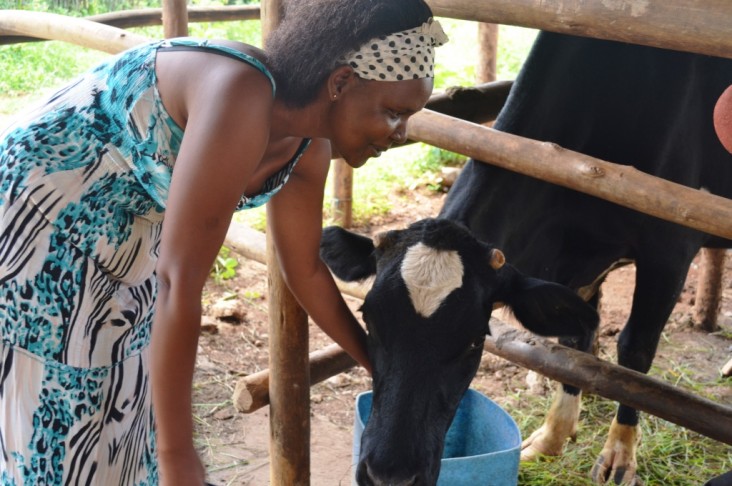
Feb. 2015—The last 15 years have not been easy since Ruth Dusabe, who lives in Kicukiro on the outskirts of Rwanda's capital, lost her husband Gilbert to illness. Until his death, Gilbert had been the sole breadwinner for their family, which made his death not only emotionally heartbreaking, but a serious economic challenge for Dusabe and her four young children. At the time, she could not afford to rent a house, and even feeding the family was a daunting task without access to land.
After a year of depending on friends for assistance, Dusabe received a small piece of land from a friend, which allowed her to cultivate crops and build a small mud brick house for her family. But even then, she and her family were only scraping by.
“Basic amenities like electricity and running water were out of the question,” says Dusabe. “The situation was terrible.”
A major turning point came in July 2010 when Dusabe acquired a cow from a government initiative that donates cows to poor families. The donation reignited her hope for a decent future. The cow was a boost to the family—and even gave birth to a calf—but milk production was poor at just 4 liters per day.
A few years later, in March 2013, Dusabe was selected to be part of a training session for small-scale dairy farmers offered through a local cooperative by USAID’s Rwanda Dairy Competitiveness Program. At the training, Dusabe and her fellow dairy farmers learned dairy farming best practices, including appropriate cow feeding for increased milk production and herd health management. In addition to training, the program provided legume seeds for participants to plant and use as improved feed for their cattle.
Following the training, Dusabe diligently implemented what she learned and was impressed when her cow’s daily milk yields more than doubled to 9 liters per day. She received regular visits from the project’s field officers and the local cooperative staff, during which they helped build on what was taught in training.
Several months later, the project arranged for the artificial insemination of Dusabe’s cow. As a result, the cow calved again about a year later. Thanks to Dusabe’s continued adoption of key training principles, her cow is now producing an amazing 18 liters of milk per day. Ruth’s family now sells 15 liters per day to local milk kiosks and consumes the remaining 3 liters. The milk consumed is a valuable source of extra nutrients for the family.
Every month, Dusabe now earns about $195 (135,000 Rwandan francs) from the sale of milk, which she describes as a windfall and a dream come true. She is now able to fully care for herself and her children, and recently was even able to extend that care to an orphaned child.
“While heading to my [house], I heard the sound of a baby crying in a deserted house surrounded by bushes. As I rescued the baby, I thought to myself that my cow’s milk is enough to save and raise this abandoned little girl,” Dusabe explained with a smile.
USAID’s Rwanda Dairy Competitiveness Program is a five-year, $15 million project implemented by Land O’ Lakes International Development under the U.S. Government’s global hunger and food security initiative, Feed the Future. Launched in 2012, the project seeks to increase the competitiveness of Rwandan dairy products to positively impact rural household incomes associated with dairy-related enterprises.
LINKS
Follow @USAIDRwanda, on Facebook, on Flickr







Comment
Make a general inquiry or suggest an improvement.